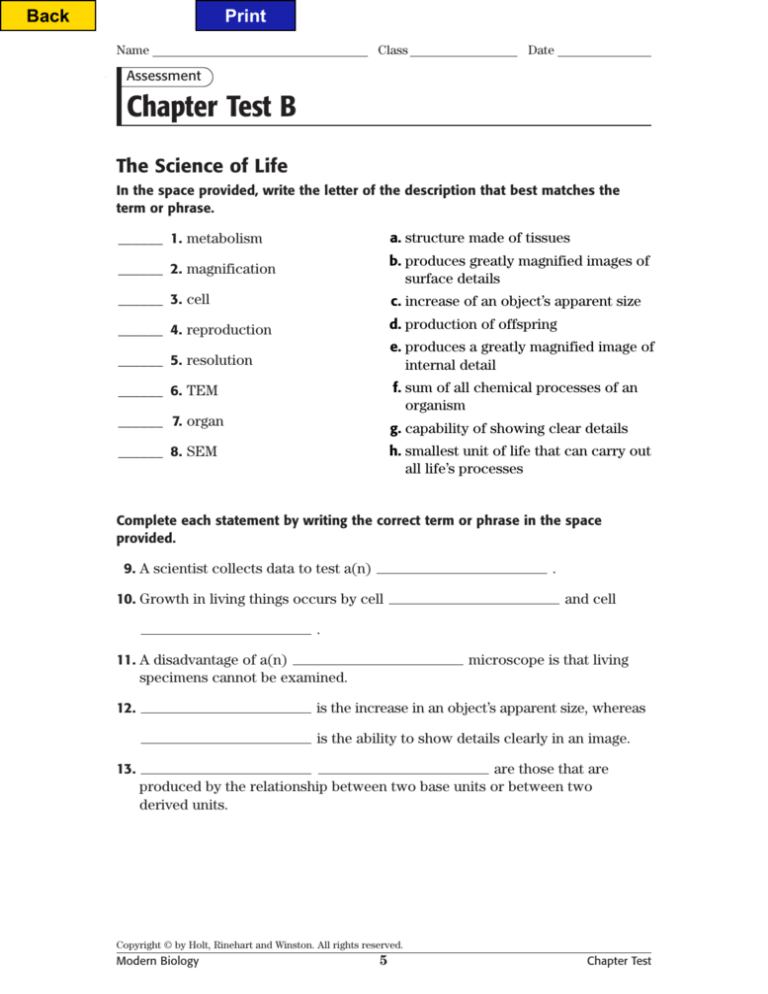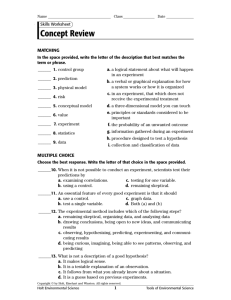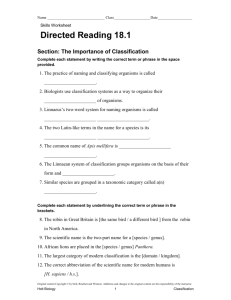
Back
Print
Name
Class
Date
Assessment
Chapter Test B
The Science of Life
In the space provided, write the letter of the description that best matches the
term or phrase.
______ 1. metabolism
a. structure made of tissues
______ 2. magnification
b. produces greatly magnified images of
surface details
______ 3. cell
c. increase of an object’s apparent size
______ 4. reproduction
d. production of offspring
______ 5. resolution
e. produces a greatly magnified image of
internal detail
______ 6. TEM
f. sum of all chemical processes of an
organism
______ 7. organ
g. capability of showing clear details
______ 8. SEM
h. smallest unit of life that can carry out
all life’s processes
Complete each statement by writing the correct term or phrase in the space
provided.
9. A scientist collects data to test a(n)
.
10. Growth in living things occurs by cell
and cell
.
11. A disadvantage of a(n)
specimens cannot be examined.
12.
microscope is that living
is the increase in an object’s apparent size, whereas
is the ability to show details clearly in an image.
13.
are those that are
produced by the relationship between two base units or between two
derived units.
Copyright © by Holt, Rinehart and Winston. All rights reserved.
Modern Biology
5
Chapter Test
Back
Print
Name
Class
Date
The Science of Life, Chapter Test B continued
In the space provided, write the letter of the term or phrase that best completes
each statement or best answers each question.
______14. To maintain their internal organization, all living things must have a
constant supply of
a. oxygen.
c. water.
b. carbon dioxide.
d. energy.
______15. Reproduction involves the transfer of genetic information from
a. genes to DNA.
b. parents to offspring.
c. offspring to parents.
d. unicellular organisms to multicellular organisms.
______16. The stable internal environment maintained by living things is called
a. homeostasis.
c. adaptation.
b. differentiation.
d. interdependence.
______ 17. The most important driving force in evolution is
a. natural selection.
c. autotrophy.
b. heterotrophy.
d. asexual reproduction.
______18. The scientific process that involves using the five senses is
a. inference.
c. modeling.
b. analyzing.
d. observation.
______19. Data that are quantitative are always
a. described in words.
b. represented by numbers.
c. duplicated for verification.
d. the most accurate kind of data.
______20. A hypothesis is a statement that
a. is always true.
b. is usually true.
c. is the same as a theory.
d. can be tested.
______21. A broad and comprehensive statement of what is believed to be true
is a(n)
a. model.
c. prediction.
b. theory.
d. inference.
______22. The safety symbol for eye safety is a picture of
a. a hand.
c. an electrical plug.
b. a flame.
d. goggles.
______23. Two parents are required for the type of reproduction known as
a. asexual reproduction.
c. sexual reproduction.
b. binary fission.
d. cell differentiation.
Copyright © by Holt, Rinehart and Winston. All rights reserved.
Modern Biology
6
Chapter Test
Back
Print
Name
Class
Date
The Science of Life, Chapter Test B continued
Read each question, and write your answer in the space provided.
24. List three major themes of biology.
25. List seven major characteristics of life.
26. Would a field biologist who studies the ecology of a bird species necessarily
use the same scientific methods as a laboratory biologist who studies how a
virus infects cells? Why or why not?
27. Why is it important for scientists to communicate about their work, and what
are two common ways that they do so?
28. Why do scientists use SI (Système International d’Unités) rather than the
system of measurement adopted for use in their own country?
29. Which step in the scientific methods does the chart below represent?
Apparent
index case
KEY
Confirmed case
Person died
Person left community
Day 1
4 cases
Day 2
6 cases
Day 3
7 cases
Day 4
12 cases
Copyright © by Holt, Rinehart and Winston. All rights reserved.
Modern Biology
7
Chapter Test
Back
Print
Name
Class
Date
The Science of Life, Chapter Test B continued
Follow the directions given below.
30. A microbiologist tested the rate of reproduction (called growth) of a bacterial
species in two kinds of bacterial food (called media). The data were organized
on the graph below. Analyze the data, and answer questions a–e.
Bacterial growth
Medium A
Medium B
0
12
24
36
Time (in hours)
48
76
a. At what time was the growth rate equal for the bacteria in both media?
b. Which medium produced the most rapid growth initially?
c. Which medium produced the most growth overall?
d. What does the descending part of the curves represent? What may have
caused this effect?
e. What can you predict about the results of a similar experiment run for one
week?
Copyright © by Holt, Rinehart and Winston. All rights reserved.
Modern Biology
8
Chapter Test
Back
Print PAGE
TEACHER RESOURCE
Answer Key
The Science of Life
Chapter Test A (General)
The Science of Life
Chapter Test B (Advanced)
1.
2.
3.
4.
5.
6.
7.
14.
15.
16.
17.
18.
19.
20.
21.
22.
1.
2.
3.
4.
5.
6.
7.
8.
9.
10.
11.
12.
13.
14.
15.
16.
17.
18.
19.
20.
21.
22.
23.
24.
c
8. f
g
9. c
e
10. c
h
11. d
a
12. b
d
13. a
b
cell
tissues, organs, organ systems
homeostasis
reproduction
closely
evolution
stimulus
metabolism
Scientists can use information in an
article in a scientific publication to
develop or modify their own hypotheses. They can also use the information
to repeat the experiments and confirm
the author’s results. Science journals
provide a means of communication for
scientists all over the world.
23. A knowledge of biology is important
so that you can make informed personal
decisions about your health, your
environment, and the way you live.
Pollution, new technologies, the
world’s food supplies, and curing
diseases are all problems that affect
human society. It is important to be
scientifically informed about these
issues.
24. Because all living things need energy
to grow, move, and interpret information, there must be a mechanism by
which organisms obtain this energy
and use it. Metabolism is the sum of
all the chemical reactions an organism
uses to carry out life.
25. Because no organism lives forever,
reproduction ensures the continuation
of a species. If organisms did not
reproduce, their species would soon
disappear.
25.
26.
27.
28.
29.
f
c
h
d
g
e
a
b
hypothesis
division, enlargement
electron
Magnification, resolution
Derived units
d
b
a
a
d
b
d
b
d
c
diversity and unity of life; interdependence of organisms; evolution of life
organization and cells; response to
stimuli; homeostasis; metabolism;
growth and development; reproduction;
change through time
No; scientists use scientific methods in
a way that is best suited to answer the
questions they ask.
Communication allows scientists to
build on the work of other scientists.
Scientists publish their findings in
journals or present them at
conferences.
The SI is a universal, standardized
form of measurement that allows
scientists to compare results.
organizing and analyzing collected
data
Copyright © by Holt, Rinehart and Winston. All rights reserved.
Holt Biology
405
Answer Key
Back
Print PAGE
TEACHER RESOURCE
30. (a) about 24 hours (b) Medium B
is dissolved. The concentration is the
amount of solute in a fixed amount of
the solution.
27. Acids have a sour taste and are highly
corrosive in concentrated forms.
Bases have a bitter taste and tend
to feel slippery.
28. The pH scale is a system of comparing
the relative concentrations of hydronium ions and hydroxide ions in a
solution. Its values range from 0 to 14,
(c) Medium A (d) The descending part
of the curves represents a decline in
the growth rate over time because of
the depletion of nutrient media.
(e) The growth rate should eventually
reach zero for the bacteria in both
media.
Chemistry of Life
Chapter Test A (General)
1.
2.
3.
4.
5.
6.
7.
8.
9.
10.
11.
a
a
a
d
b
d
d
d
c
b
c
12.
13.
14.
15.
16.
17.
18.
19.
20.
21.
22.
23.
24.
25.
polar, nonpolar
hydrogen, covalent
water
hydronium
sodium ions, chloride ions
catalyst
f
a
e
h
b
d
c
g
with values less than 7 denoting acidity and those greater than 7 denoting
alkalinity.
29. atomic mass: 14; atomic number: 6
30. (a) pepsin (b) trypsin (c) The liquid
must become alkaline. (d) According
to the graph, enzymes function best at
certain pH levels. (e) No; according to
the graph, a low pH is required for
pepsin to function, and a high pH
is required for trypsin to function.
Biochemistry
Chapter Test A (General)
1.
2.
3.
4.
5.
6.
7.
8.
9.
10.
20.
21.
Chemistry of Life
Chapter Test B (Advanced)
1.
2.
3.
4.
5.
6.
7.
8.
9.
10.
11.
d
g
f
e
h
a
b
c
a
c
d
12.
13.
14.
15.
16.
17.
18.
19.
20.
21.
22.
23.
a
a
b
b
a
d
b
a
d
d
a
c
24. In redox reactions, electrons are trans-
ferred between atoms, so the reactions
always occur together.
25. In living things, enzymes act as catalysts
to speed up chemical reactions.
26. A solute is the substance that is
dissolved in a solution. A solvent
is the substance in which the solute
c
11. e
c
12. h
a
13. c
b
14. b
c
15. f
a
16. d
c
17. g
d
18. j
b
19. a
i
A—carbohydrate; B—lipid; C—protein
Carbohydrates such as the monosaccharide glucose shown here are found
in cells as a source of energy (glucose), as energy storage molecules
(glycogen and starch), or as structural
molecules (cellulose). Lipids such as
the fatty acid shown here are found in
cells as energy storage molecules
(fats) or in cell membranes as structural molecules (phospholipids).
Proteins are found in cells as enzymes
and structural proteins in the body
(hair, muscles).
Copyright © by Holt, Rinehart and Winston. All rights reserved.
Modern Biology
406
Answer Key








